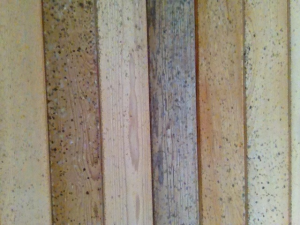Mould and Clean up Q+A
GBE > Encyclopaedia > Code > Question+Answer > Q#40985
Mould and Clean up (Q+A) G#40985
About:
‘Brian Murphy, Sustainable Design and Construction Expert on HiiGuru’
Question 1
- Why does mould form in the home?
Answer 1
- Life generates moisture vapour and heat:
- Human activity generates heat and moisture vapour by breathing and sweating.
- The more vigorous the activity the more heat and moisture vapour generated.
- Other activities generate heat and moisture vapour:
- Bathing, showers, clothes washing, washing machines, clothes drying machine, clothes airing.
- Cooking, boiling, steaming, washing dishes, dishwashers, etc.
- Moisture vapour pressure inside buildings varies all the time depending upon what activities are happening at any moment.
- Moisture vapour pressure and heat will drive moisture vapour movement towards lower temperatures and lower vapour pressure, whether that is inside of outside, at any moment.
- Adult humans generate 100 watts of heat at rest whilst an Olympian at full tilt may be 2000 watts.
- Human activity generates heat and moisture vapour by breathing and sweating.
- Weather generates water, moisture vapour, warmth or coolth and precipitation.
- Weather generates warmth or coolth:
- Warmth in the air can hold more moisture vapour with high relative humidity.
- Coolth in the air can hold less moisture vapour with low relative humidity.
- Changing air temperatures from warm to cool can no longer hold as much moisture vapour leading to phase change from moisture vapour to water precipitation into air or onto surfaces.
- Precipitation generates water on surfaces and moisture vapour in the air; more moisture vapour is generated as that water evaporates from surfaces into the air.
- Moisture vapour pressure outside of buildings varies all the time depending upon what weather is happening at any moment.
- Buildings and Moisture Vapour
- Moisture vapour pressure and heat will drive moisture vapour movement towards lower temperatures and lower vapour pressure.
- Because moisture vapour pressure and temperatures continually fluctuate inside and outside of a building then moisture vapour pressure will travel inwards or outwards depending on the relative conditions inside and outside.
- Encountering cold surfaces:
- When warm moisture vapour laden air meets cold surfaces or damp surfaces then moisture vapour can condense out on to those cold surfaces as water.
- Mould spores from fungi in nature are everywhere and ever present in the air we breathe and encounter in our homes and places of work and in the layers of their construction.
- When the spores encounter a damp surface they can be adsorbed onto the surfaces as surface condensation and that moisture will reactivate the spores to grow mould.
- When moisture vapour passes through walls when it encounters a cold component it too can condense into water as interstitial condensation.
- Where spores are present in the construction from the building stage they too can be reactivated.
- Mould can grow and create fruiting bodies that release more mould spores.
- Mould can affect the respiratory tracts of humans and pets, leading to asthma and at worse death.
- In America toxic mould can take over a building and make it uninhabitable and not safe to enter.
- Mould can penetrate materials and initiate rot, damaging building materials and potentially cause structural failure.
Question 2
- Where does mould form in the home?
Answer 2
- Rooms:
-
- Bathrooms, Shower Rooms, Utility, Kitchen, Boot room, Bedrooms, Dressing room, Teenagers room, Man caves, Garage, Entrance Porch, Conservatory, Green House, Jacuzzi room, Swimming pool room, Sauna, Basements.
- Cold surfaces:
- Single glazing. Double glazing in a highly insulated house.
- Window and door jambs (sides of opening), lintels and sills especially if the windows are set close to the outer or inner face of the wall, creating a diagonal thermal bridge between the window and any external insulation, within the cavity or internal insulation.
- Bay windows
- Around roof lights
- In Lofts (with compromised cross ventilation)
- In suspended ground floor voids (with blocked air bricks)
- Cornice adjacent to the roof eaves, especially if insulation has been added to the loft, it will probably be thin insulation just at that corner, creating a thermal bridge, and wind washing by cold external air blowing the heat out of insulation in the loft close to the eaves.
- Anywhere that insulation stops and starts, example External Wall Insulation either side of external rainwater pipes, gutters and soil and vent pipes.
- Skirting at ground floor external walls especially if you have fitted carpets, the gap below and behind skirtings is a draughty cold spot and mould can start in the edge of the carpet under the skirting.
- Problems:
- Construction moisture in the first heating season is a high risk.
- Insufficient ventilation of building.
- Open water tanks heated from house below.
- Services penetrating ceiling not sealed.
- Air leaky and uninsulated loft hatches.
- Air leaky dry linings and junctions.
- Cavity walls open at top, open into roof void.
- Historic ceilings with no vapour barrier.
- Solutions:
- Ventilation of the building is essential.
- Cover all water tanks in loft.
- Seal all penetrations in the ceiling.
- Make loft hatches convection-tight, weather stripping under pressure of latch hooks.
- Ensure continuity of jointing at wall to ceiling joint and behind linings.
- Ensure masonry wall cavities do not interconnect with roof cavities.
- Consider adding a ceiling Airtight Vapour Control Layer (AVCL).
- Or add a Vapour tight paint to ceiling.
Question 3
- Prevention is better than cure: How do you prevent mould from forming in the first place?
Answer 3
- We cannot stop breathing, sweating, cleaning, cooking and eating.
- We can reduce our heating demand by dressing warmer and better insulating our homes.
- Resolve the thermal bridges with more appropriate insulation and better detailed solutions.
- PAS 2030 (a guide to risk free home improvement) slogan: No Insulation without Ventilation
- Moisture is ever present it needs a way out to lower the internal moisture vapour pressure.
- In walls, floors and roofs: Vapour barriers to stop vapour getting into construction Breather membranes to help vapour getting out.
- Passive ventilation, trickle vents, open windows, open doors, ajar windows, ajar doors, rooflights, airbricks, extractor fans.
- But in winter your ventilation does not want to be squandering heat or consuming too much energy.
- Night-time purging ventilation.
- Mechanical ventilation, Mechanical extractors in bathrooms and kitchens with automatic controls to achieve one air change.
- Mechanical ventilation with heat recovery
- Air conditioning but that is money, energy and carbon intensive and should be avoided.
Question 4
- What are the best ways to remove mould?
Answer 4
- This will depend on whether it’s a painted wall, grout or a shower curtain.
- There are so many natural recipes that you do not need to buy special cleaners.
- https://greenbuildingencyclopaedia.uk/
- environmental-cleaning-solution/
- You can also avoid high chemistry cleaners that could affect your health, short or long term.
Question 5
- What precautions should you take when removing mould? – wear protection gloves, etc.?
Answer 5
- Don’t use chemistry to clean the mould or you will need to use PPE Personal Protective Equipment, goggles, gloves, hazmat suits, etc.
- Some cleaners including bleach can also spoil your clothing, so wear old work ware, boiler suits, etc.
© GBE GBC GBL NGS ASWS Brian Murphy aka BrianSpecMan **
19th Sepember 2023 – 20th September 2023
Mould and Clean up (Q+A) G#40985
Images:

Mould and Clean up (Q+A) G#40985
See Also:
GBE Solution
- Environmental Cleaning (Solution) G#741 N#763
GBE Sign Up
- GBE Membership (Sign-Up) G#23472
GBE #Hashtags
GBE Slogans
- Build Light Insulate Right Solar Tight (Slogan) G#2272
- Fabric First Materials First Performance First (Slogan) G#17243
- Stuffed Loft; Squashed Insulation; Lift Your Loft Stuff (Slogan) G#13957
GBE Q&A
Legend
- Statement No.: S1, S2, etc.
- Observation No.: O1, O2, etc.
- Comment No. C1, C2, etc.
- Question No.: Q1, Q2, etc.
- Answer No.: A1, A2, etc.
Pages
- Energy Saving and Noise Reduction (Q+A) G#3204
- Suspended timber floor retrofit insulation (Q+A) G#3870
- Thermal insulation existing timber stud external walls (Q+A) G#1803 N#1690
- Energy and Acoustics Measures (Q+A) G#1484 N#1444
- Primitive Materials Future Building (Q+A) G#16244
GBE Checklist
- Decent Homes (Checklist) G#1571 N#1507
- Refurbishment Decent Homes (Checklist) G#1253 N#1252
- Green Deal Refurbishment (Checklist) G#730 N#752
- Other issues (Checklist) G#1570 N#1506
- GBE New Build Checklist (Navigation) G#606 N#627
- A90 Performance Specification (Checklist) G#1715 N#1617
- A91 Prescriptive Specification (Checklist)
- A94 Airtightness testing on-site (Checklist) G#1720 N#1622
- A95 Infra-Red Thermographic Surveys (Checklist) G#1721 N#1623
- C Existing Site/Building/Services (Checklist) G#1558 N#1498
- E In situ concrete/Large precast concrete (Checklist) G#649 N#671
- E41 Worked Finishes to Concrete (Checklist) G#723 N#745
- F10 Brick/Block Walling (Checklist) G#1647 N#1561
- G Structural/ Carcassing metal/ timber (Checklist) G#1596 N#1526
- G20 Carpentry Timber Framing First Fixing (Checklist) G#1597 N#1527
- H Claddings Coverings (Checklist) G#1735 N#1635
- H21 Timber Weatherboarding (Checklist) G#11946
- K43 Raised Storage Access Systems (Checklist) G#13934
- L10 Windows (Checklist) G#1605 N#1534
- L10 Windows Rooflights Screens Louvres (Checklist) G#1604 N#1533
- M21 Insulation With Rendered Finish (Checklist) G#9442
- M50 Rubber Plastics Cork Lino Carpet tiling sheeting (Checklist) G#1160 N#1164
- Z10 Purpose Made Joinery (Checklist) G#1593 N#1524
GBE Issue Papers
- Squashed Loft Insulation (Issue Paper) G#13919
GBE CPD
- Surveys Tests Analysis (CPD Lecture) G#389 N#390
- Refurbishment Decent Homes Checklist (CPD) G#644 N#666
- Retrofit PAS 2035 (CPD) G#21613
- Sustainable Refurbishment Materials Specification (CPD) G#38046
GBE Lectures
- (13.1) Ground Floor (Lecture) G#2112 N#213
- (21) Masonry External Walls (Lecture) G#2115 N#216
- (21) Timber Frame (Lecture) G#2117 N#219
- (23) Upper Floors (Lecture) G#2120 N#222
- (27.2) Pitched Roofs (Lecture) G#2122 N#224
GBE Shop
- GBE Lecture (13.1) Ground Floors (Shop) G#11561
- GBE Lecture (21) Masonry External Walls (Shop) G#11559
- GBE Lecture (23) Upper Floors (Shop) G#11554
- GBE Lecture (27.1) Flat Roofs (Shop) G#11501
- GBE Issue Paper Overheating (Shop) G#10433
GBE Defects
- Weather Protection (Defect) G#728 N#750
- Attic cistern thermal insulation enclosure (Defect) G#1041 N#1058
- Loft Insulation (Defect) G#14166
GBE Issue Papers
- Squashed Loft Insulation (Issue Paper) G#13919
- Overheating (Issue Paper) G#145
- Moisture in Timber (Issue Paper)
GBE Brainstorms
GBE Products
- Diathonite Evolution (Product) G#1796 N#1683
- Breathaplasta (Product)
- Breathaboard (Product)
GBE Accessories
- Insumate 600 Tray (Accessories) G#1762 N#1658
GBE Systems
GBE Materials
- Aerogel
- Cellulose flake recycled newspaper
- Clayboards
- Clay plasters
- Dense wood fibre Insulation
- Glass wool
- Hemp-lime
- Stone wool
- Vacuum Insulated Panel (VIP)
GBE Manufacturers
- Adaptavate (Manufacturer)
- Ampack
- Argilus
- Diasen
- EBB
- Eco Answers Ltd t/a LoftZone (Manufacturer) G#13890
- Enviroform Solutions Ltd (Manufacturer) G#4728
- Gemini Adhesives Ltd (Manufacturer) G#1166 N#1170
- Gutex
- Insumate Ltd (Manufacturer) G#1761 N#1657
- Lime Technology
- Lime Green
- Pavatex
- ProClima
- Schneider
- Steico
- Ty-Mawr Lime Ltd (Manufacturer) G#891 N#911
- Unger Diffutherm
GBE Suppliers
- Back to Earth (Supplier)
- Eco Answers Ltd t/a LoftZone G#13890
- EcoMerchant (Supplier) G#887 N#907
- Ecological Building Systems (Supplier) G#886 N#906
- Mike Wye & Associates (Supplier) N#910
- NBT Natural Building Technology (Supplier)
- Partel (Supplier)
- Ty-Mawr Lime Ltd (Manufacturer Supplier) G#891 N#911
GBE Installers
GBE Servers
- Enviroform Solutions Ltd G#4728 (advice on all insulation types, provide fit for purpose solutions)
GBE Projects: Events
- Building Defects Conferences
- Curtain Walling
- Cladding
- Building Performance Conferences
- Curtain Walling
- Cladding
© GBE GBC GBL NGS ASWS Brian Murphy aka BrianSpecMan **
20th September 2023


